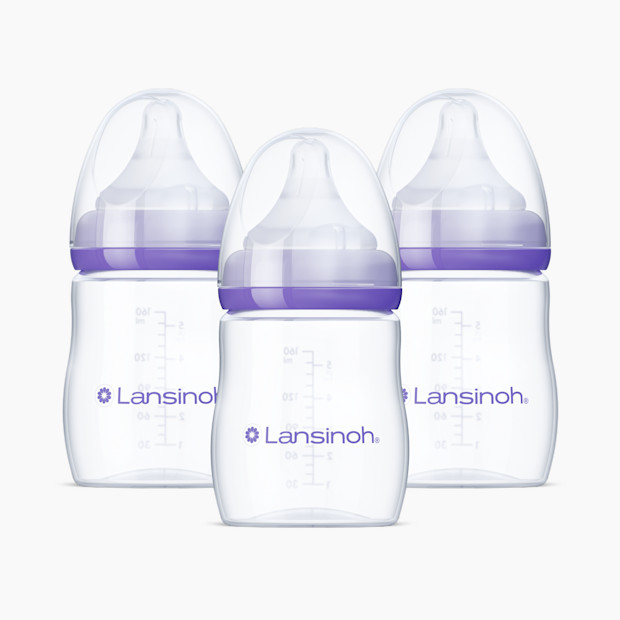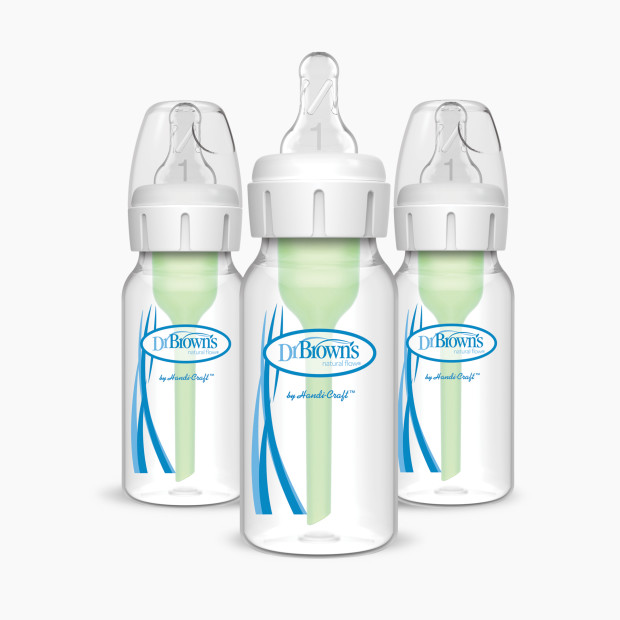
The Best Bottles for Breastfed Babies
These bottles can help your baby seamlessly transition between breast and bottle.

By Briana Engelbrecht and Jen LaBracio, CPST
Medically Reviewed by LC De Shay-Evans
Fact Checked by Shannon Vestal Robson

In This Article
One of the most intimidating parts of breastfeeding is the feeling that you’re the sole source of nourishment for your baby. Which is why introducing a bottle, and allowing your partner or another caregiver to occasionally feed baby, can be so helpful. But ask any parent who has exclusively breastfed the first few weeks (or months) of their baby’s life and you’re sure to hear how tricky it can be to navigate the introduction of a bottle.
This is where bottles specifically designed with the anatomy and mechanics of breastfeeding come into play. Bottles come with all kinds of nipple shapes, sizes and flows—and even different feels. But a few characteristics in particular make certain options more suitable for transitioning from breast to bottle (and back). The ideal bottles for breastfed babies closely resemble the shape and feel the breast and nipple takes during nursing. This means they’re able to achieve the same deep latch they use when breastfeeding.
After extensive research and testing, the Laninsoh Bottles are our best overall pick because they pass the triangle test (more on that below), are easy to clean, affordable and easy to find at retailers and online. But babies are notoriously picky when it comes to their bottles, so we have a few other options including anti-colic and glass bottles. (Note: We also want to reassure you that if your baby doesn’t like any of these picks, it’s also okay to go with a bottle that’s not specifically breastfeeding-friendly—so be sure to check out our other bottle guides for more suggestions.)
Why Trust Babylist?
Babylist is the expert in baby; we know baby gear inside and out. We talk with parents face-to-face in our showroom and on our user panels and hear from thousands annually via our Best Baby Products online survey. We know what items millions of expecting parents are adding to their baby registries.
Firsthand and professional experience. As a mom of two (who breastfed both babies), I’ve had the opportunity to test out dozens of bottles during my own feeding journey with both of my children. I’ve also completed 52 hours of training to become a certified lactation counselor (CLC) and used both of these experiences to help choose the bottles on this list.
Expert POV. For an expert POV, I spoke with physical therapist and International Board Certified Lactation Consultant (IBCLC) Emily Spaeth, founder of Be Well Baby PDX and Allyson Murphy, IBCLC, founder of Lactation Ally based in New Jersey. IBCLCs are the highest accredited healthcare professionals in lactation; they’ve completed years of training requirements including lactation-specific education and hands-on clinical training.
Baby bottle data. I regularly analyze which baby products our users are adding to their baby registries the most (and which ones they aren’t) and what our team of Merchandising experts—our buyers who are responsible for ensuring the Babylist Shop is stocked with the best and newest gear—is excited about. Studying this kind of data helped us choose which breastfeeding-friendly bottles to narrow in on and which ones to recommend to new and expecting parents.
Feedback and reviews. I reviewed comments and feedback from Babylist’s annual product survey of thousands of parents, read customer reviews from hundreds of Babylist users and spoke to parents on our staff about their real-life product experiences.
Best Bottle for Breastfed Babies Overall
Lansinoh Anti-Colic Baby Bottles - 5 Oz
From $18.69Pros
- Gradual nipple shape mimics breast anatomy
- Encourages a natural, wide latch
- Can pump directly into the bottles
Cons
- Some parents say the nipples leak and tear easily
- Slowest flow may still be too fast for some babies
One of the most important factors in choosing a bottle for babies who are typically breastfed is nipple shape—and this is one of the most ideal. The nipple is ergonomically designed to mimic the natural breast and nipple shape, which allows baby to use the same sucking motion for each, and it eases the transition between breast and bottle. “I used this bottle after looking for a nipple similar to the breast that had a slow flow nipple. My son immediately loved this bottle,” one Babylist parent wrote in their review.
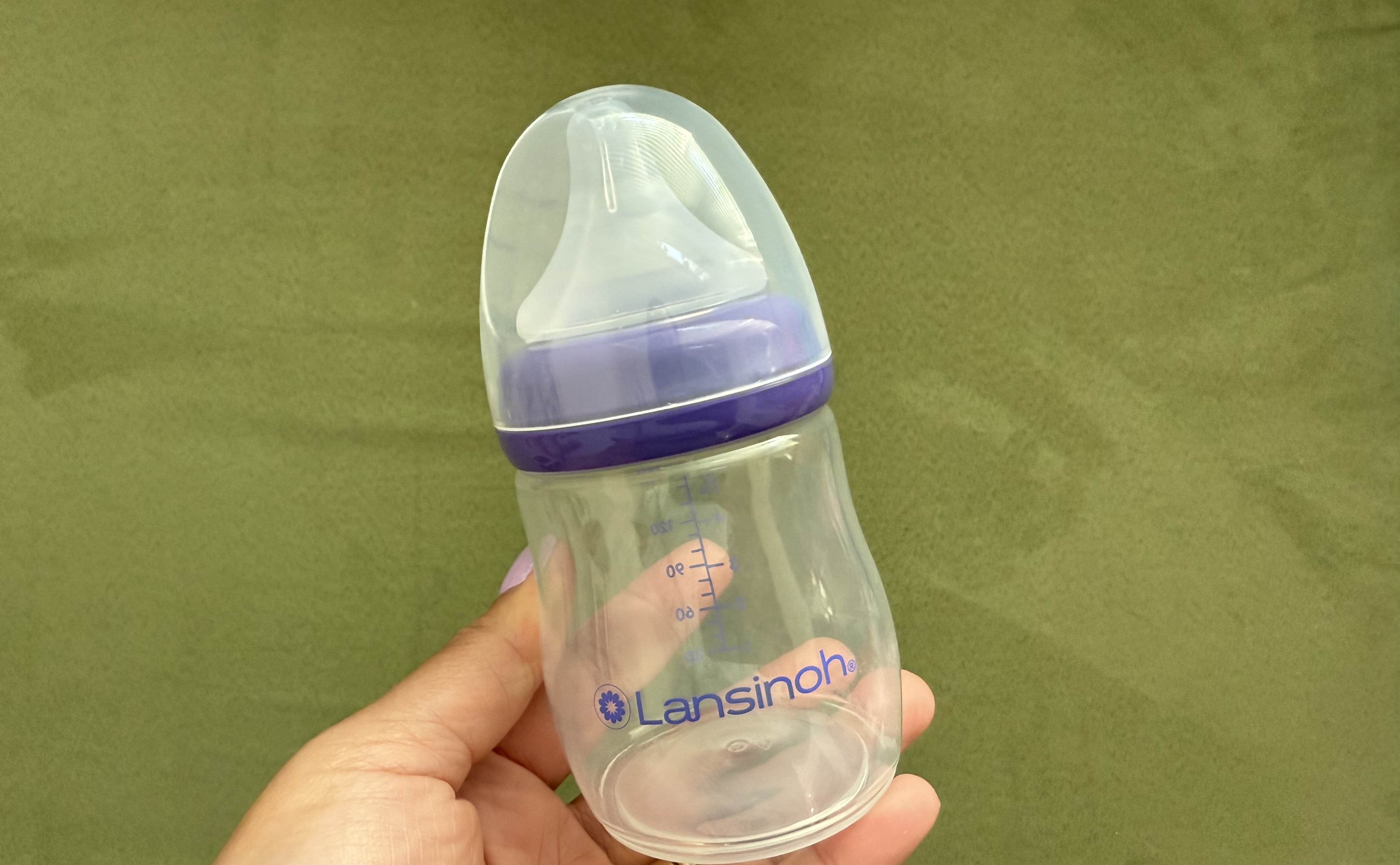
Lansioh bottle
When baby is nursing at the breast, they’re latching onto breast tissue and the nipple (so you want a nipple they can get a wide latch on versus one they’re just sucking the long nipple of). “It [passes] the triangle test, meaning the shape of the bottle's nipple mimics breastfeeding,” one Babylist parent said in their review. The “triangle test” is one way you can gauge whether a particular nipple will encourage a deeper latch; to do it, you create a triangle with your two index fingers over the bottle nipple. The less space between the nipple and your fingers, the deeper a latch baby can get.
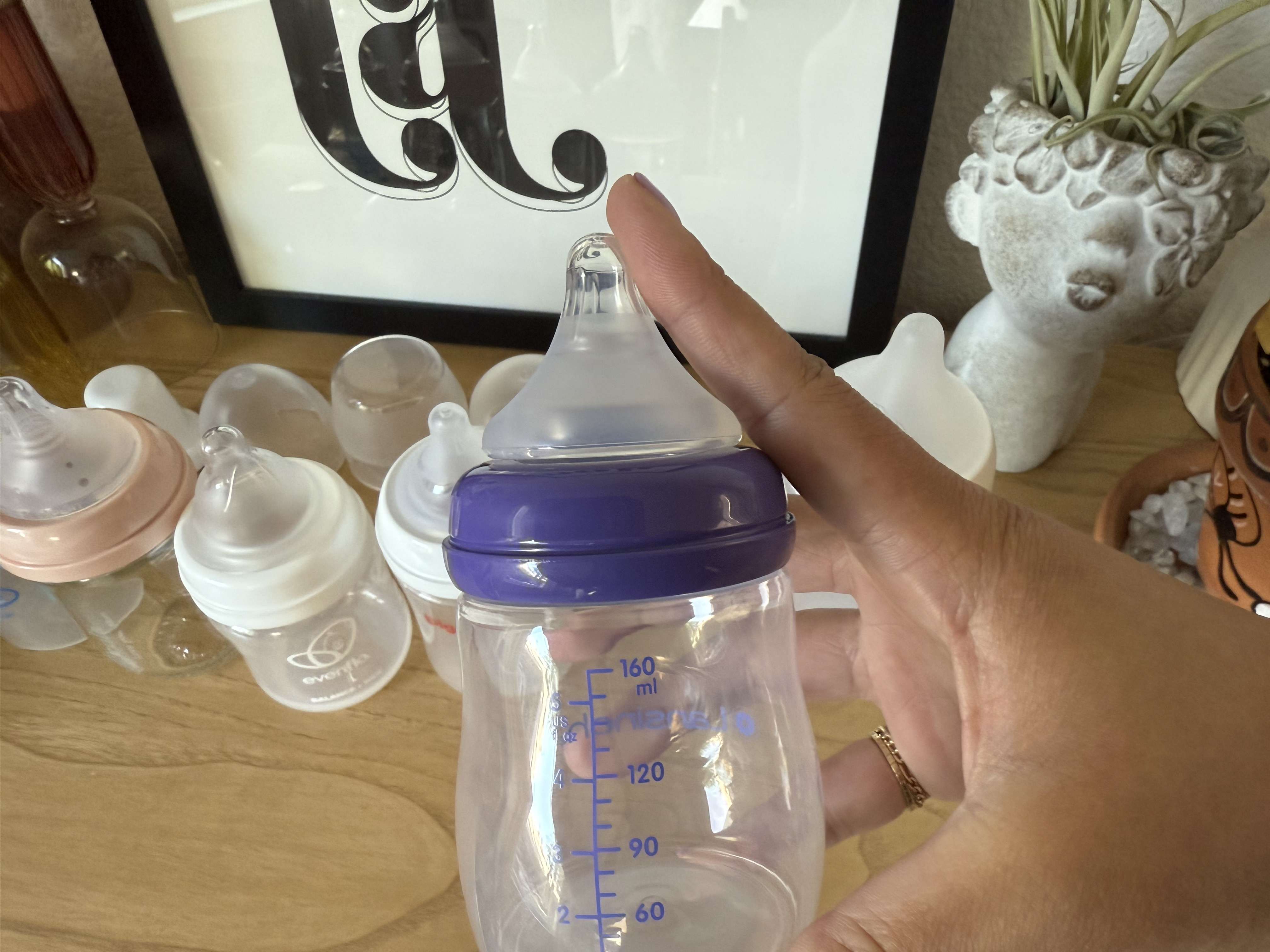
A one-handed example of the triangle test.
The Lansinoh is also a pretty straightforward and simple bottle—there aren’t many parts to clean and keep track of (another thing multiple Babylist parents mention in their reviews). There’s also a venting system to reduce air intake and an inner vertical groove on the nipple that prevents collapse. Also, if you’ve got a Lansinoh breast pump, you can pump directly into these bottles for easier milk storage (other breast pumps may also work with compatible adapters). Parents who prefer glass bottles can find a glass version on Laninoh's website.
There are a few things parents don’t love about this bottle—the most common gripe mentioned in reviews is that the nipple isn’t as slow as parents would like, which makes milk leak. “I have been using these bottles for 313 weeks now [and] the nipples are not slow flow—they dribble. [The] concept is a good idea as far as the nipple shape but any breastfeeding mother is going to want a truly slow flow nipple,” one parent said. Some also mention the nipples rip easily, which could be due to their more pliable feel. “[The] nipple is too soft, so when I put it in my dishwasher (gently, I might add) the FIRST time, it poked a hole right through,” one said. Keep in mind you may need to purchase nipple replacements frequently depending how rough you are with them.
Runner-Up
Pros
- Ideal shape for latching that mimics the breast
- Line to guide proper latch
- Easy to clean
Cons
- Nipple flow sizing can be confusing
- Pricey
- Can be hard to find
It was really hard to choose between the Pigeon bottles and Lansinoh because they’re super similar. If your breastfed baby is struggling with taking a bottle (and perhaps Lansinoh didn’t work out), many lactation consultants will tell you to try a Pigeon bottle. This Japanese brand is known for its nipples that help even the most stubborn of bottle refusers.
The secret lies in the nipple’s size, feel and shape—it’s thinner than many other bottle nipples, breast-shaped with a gentle slope and features a textured surface and inner ridges to prevent collapse. “My son was exclusively breastfed for the first two months so when he started daycare he refused bottles for several weeks. We tried Dr. Brown’s narrow and wide, Como Tomo and Philips Avent, to no success. Finally a friend of mine who’s a lactation consultant recommended these and he took to these bottles IMMEDIATELY,” one parent raved in their review. The nipples even have a helpful latch line to give you an idea of how deeply baby should be latched onto the bottle.
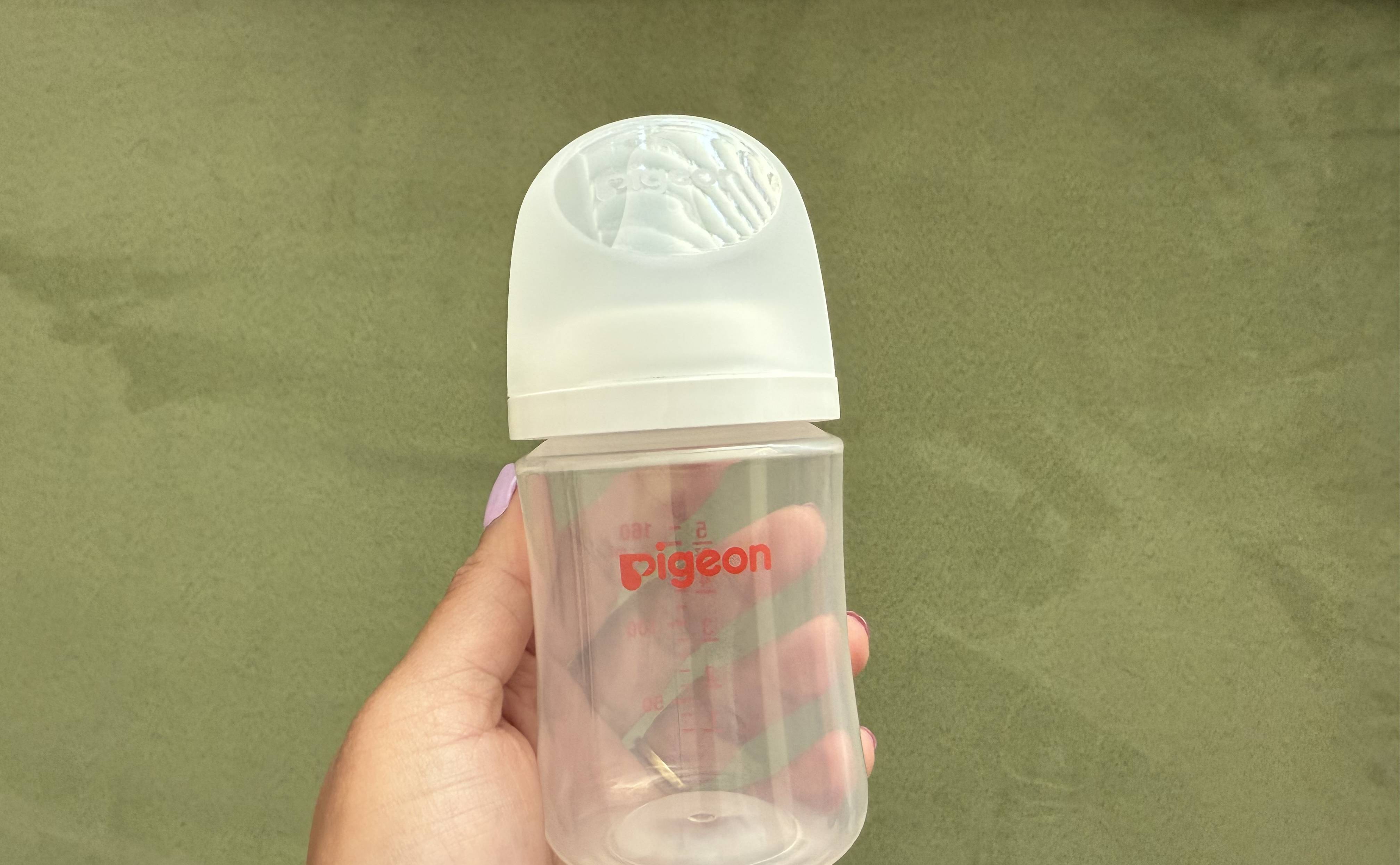
Pigeon Nursing Bottle
In addition to the gradual slope that encourages a deep latch, the nipples have a slow flow, which is ideal for breastfed babies since it mimics the letdown process that happens when they’re nursing at the breast. (Pro tip: Pigeon bottle nipples also work with some other bottle brands, including the Lansinoh bottles featured in this guide.) If you prefer to stay away from plastic bottles, Pigeon also offers a glass version, too. The bottles only have four pieces—the nipple collar, bottle and cap—which means there aren’t a bunch of parts to clean. And there is a built-in anti-colic feature to help prevent swallowing air.
The main reason this didn’t win best overall is because it can be tricky to find these bottles. While they’re available on Amazon, Pigeon’s website and a few small online shops, you won’t find them at retailers like Target or Walmart. They’re also quite expensive compared to the other bottles in this guide—though parents who were struggling getting their breastfed baby to take a bottle say the cost is worth it.
Another complaint is that the nipple sizing can be challenging to figure out, since it doesn’t align with the way other popular bottle brands. There is a wide variety of flow rates available, ranging from SS (super slow, for newborns) to 3L (recommended for babies 15 months and up). But quite a few parents say even the slowest option is still too fast for their babies. “I would take [a] cue from your baby on the flow rates as I don’t know how accurate the recommended ages are,” one parent wrote in their review.
Most Affordable Bottle for Breastfed Babies
Pros
- Sloped nipple mimics natural breast anatomy
- Few pieces for easy cleaning
- Also come in a glass version
Cons
- Measurements can be tough to see when filled with milk
- Some parents say the medium-flow nipples collapse easily
- Prone to leaking if the cap isn’t put on correctly
Developed with a pediatric feeding specialist, these bottles feature a “triangle test”-approved sloped nipple that’s specially designed to help your baby position their mouth for a proper latch. And best of all, these are a budget-friendly alternative to some of the other picks on this list. A pack of six comes out to around $3.50 per bottle (depending on the retailer you’re purchasing from).
The slow-flow nipples help your breastfed baby pace their feed and the integrated venting system prevents excessive air from getting into their belly. “The wide triangle fit and slow feed nipples are recommended by lactation specialists and two of mine recommended this brand,” one parent said in their review. They're also easy to clean, having few pieces to keep track of.
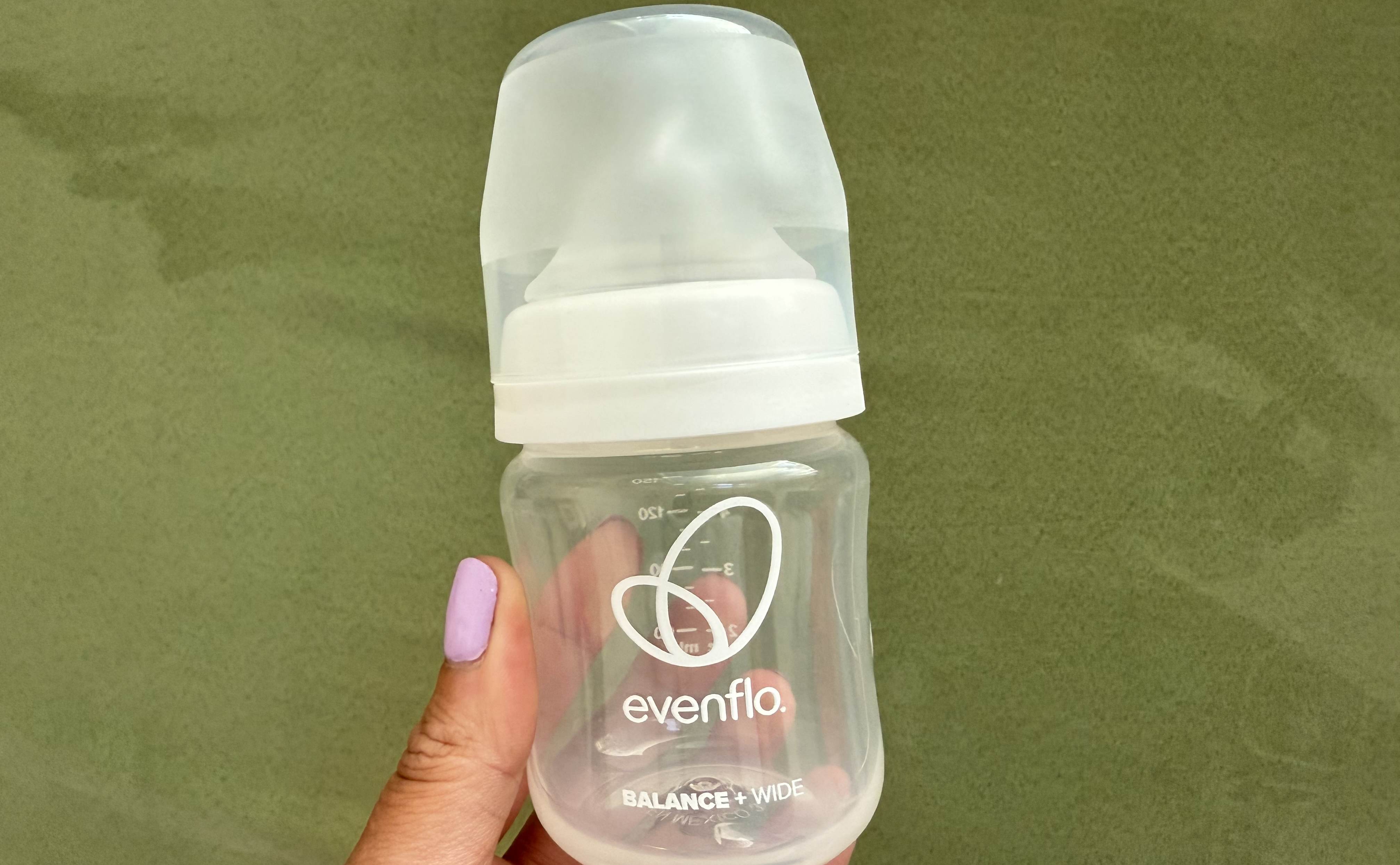
Evenflo Balance 5 oz. bottle
The biggest downside to these bottles is a design flaw: the measurements can be a bit tough to see because the markings on the bottle are white, which vanishes when the bottles are filled with milk. “The font on the bottles is white, which makes it really difficult to read when filling. It also starts at 60ml so if my baby doesn’t finish a bottle I have to guess what’s left,” one parent wrote in their review. Some parents also find that the nipple collapses easily and it leaks if not assembled just so.
Best Glass Bottle for Breastfed Babies
Pros
- Sloped nipple with a slow flow
- Made of durable glass
- Easy to clean
Cons
- Pricey
- Mainly sold on Amazon
While plastic bottles are safe for babies, some parents prefer to stick to glass bottles. Very few have nipples that pass the triangle test, but this one from lesser-known brand Gulicola do. The nipple is similar to the Lansinoh, Piegeon and Evenflo bottles and is actually softer and more flexible. Many parents say their baby accepted this bottle relatively easily: “[We] went through several name brand bottles and baby didn't take to any. The nipple on this bottle is soft and moveable like a breast and [my] baby latched on to it easily. The slower flow [is] similar to when he's on the breast.”
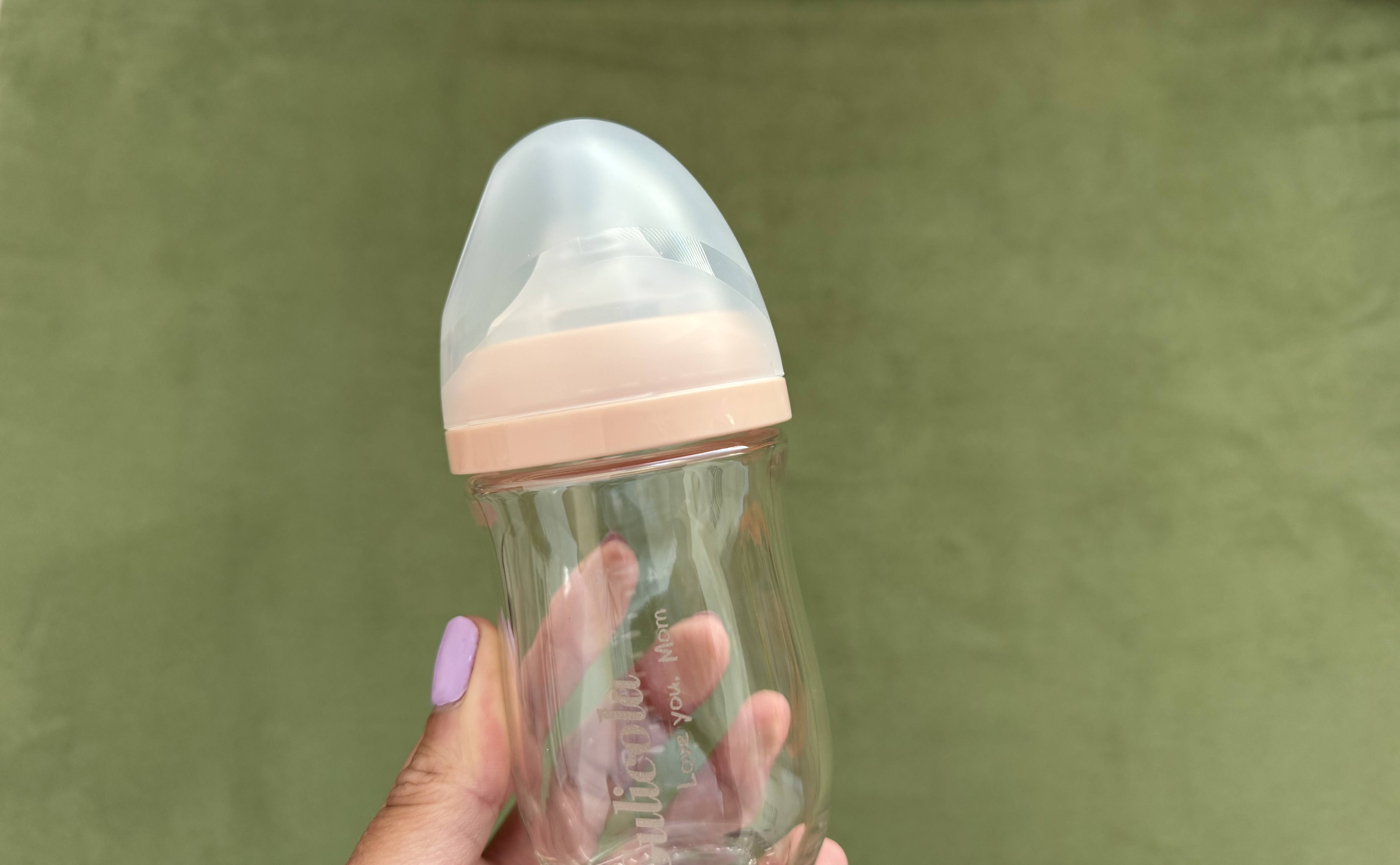
Gulicola Glass Bottle with a lid
Glass bottles can be somewhat heavy by design, but parents agree these are actually pretty comfortable to hold and are lightweight. One parent raved, “My baby is mostly [breastfed] but takes these bottles with no issue! They are great quality. The nipple is super soft and flexible which is nice and the glass is very lightweight,” one parent wrote in their review. A few parents noted that these nipples can be used with Pigeon bottles and Lansinoh. I tested this out myself and found that both Pigeon and Lansinoh nipples fit this Guilicola bottle and vice versa. The nipples are all very similar in size and shape.

Pigeon, Gulicola and Lansinoh bottle nipples
There are two things to keep in mind with these bottles: the higher price tag and somewhat limited availability. Glass bottles tend to be more expensive than their plastic counterparts, and these are no exception. They cost around $15 per bottle, which you must buy in a two pack, and get a little bit cheaper if you buy the larger pack of six (making it around $10 per bottle). They’re also a smaller brand, and like Pigeon bottles, seem to only be available to purchase on Amazon. The design also doesn’t have any anti-colic features to help prevent air intake. “After a while of using these, my baby became colicky. We had to switch to anti-colic bottles, and that has helped her a lot. Sucks because I really loved these,” one parent reviewed. So if your baby is prone to gassiness, these are probably not the best pick (though our next pick might be perfect).
Best Anti-Colic Bottle for Breastfed Babies
Dr. Brown's Anti-colic Options+ Narrow Baby Bottle - 4 Oz
From $18.98Pros
- Venting system helps prevent air bubbles while feeding
- Can also be used without the venting system
- Consistent nipple flow
Cons
- A lot of parts to clean
- Some parents say these bottles leak
Breastfed babies typically don’t swallow much air when they’re nursing (as long as they’re latched correctly), but switching to bottles can sometimes introduce air while they’re getting the hang of the different shape, feel and material of the bottle. Dr. Brown’s unique venting system eliminates air bubbles during feeding, reducing the likelihood of gas, spit-up and even colic. While their nipple shape doesn’t closely mirror a natural nipple anatomy, they do pass the triangle test. And they're so popular for a reason—many babies take them just fine due to their consistent, predictable flow. “Dr. Brown uses a laser to create the hole in the nipple of [their] bottles,” says Emily Spaeth, IBCLC and founder of Be Well Baby PDX.
Dr. Brown’s Options+ bottle
The biggest gripe with these bottles is all.of.the.parts. There are quite a few to clean, keep track of and put back together. And although this set does come with level one slow-flow nipples, lactation consultants recommend purchasing a preemie nipple to help breastfed babies transition to the bottle. You can also easily remove the venting system once your baby outgrows it.
Bottles can be tricky to figure out for any baby, but especially for babies who are used to feeding at the breast. It can take a bit of trial and error and your baby might not like any of the top picks above. So here are a few more bottles to consider:
Do I need bottles if I plan on breastfeeding my baby?
Even if you plan to exclusively breastfeed your baby, it’s a good idea to have at least one or two bottles on hand. They can come in handy for many reasons, including if you need to be away from your baby, you want to have someone else help feed them from time to time or you’re navigating challenges with breastfeeding. You don’t need a full stash to start—just a few should be enough to cover early needs.
When to Introduce a Bottle for a Breastfed Baby
You typically want to make sure breastfeeding is well established before introducing the bottle, for the most success at both feeding methods. But you also don’t want to wait too long. Allyson Murphy, an IBCLC, says the sweet spot for introducing a bottle is between three and six weeks, “Because babies have a natural instinct at that time to suck on anything you put in their mouth.”
What makes a bottle good for breastfed babies?
The oral motor function required to suck from a breast versus a bottle is very different. And ultimately, “The perfect bottle for your breastfed baby is the bottle that your baby will take,” says Murphy. But a few specific bottle features can help make babies a more willing participant to the transition from breast to bottle. Here are the things many lactation professionals recommend looking for when choosing a bottle for breastfed babies:
Nipple type
This is one of the most important features and a great place to start. Many lactation consultants recommend looking for a bottle with a nipple that has a gradual slope, meaning the top of the nipple is narrow and then gradually slopes outward toward the bottom (or base). Why? That shape encourages baby’s mouth to open wider and achieve a deep latch when feeding from a bottle that closely resembles how they latch on the breast. However, keep in mind that every baby is different, and some babies will have no problem drinking from a bottle that doesn’t have this kind of sloped nipple. You also may have to experiment with a few different brands to see what your baby prefers.
Nipple flow
It’s best to start with a slow-flow nipple when introducing a bottle to a baby who is regularly breastfed. When babies are breastfeeding, there are natural pauses in milk flow and they have to work to stimulate a let down. Some of the frustration or confusion that can happen for babies when switching between breast and bottle is that they don’t have to work as hard to express milk from a bottle nipple, especially if it’s not a slow-flow option. Think of it like when you're drinking from a straw: you simply suck and liquid comes out. A slow flow nipple allows them to feed at a pace that’s more inline with breastfeeding. (Tip: this is also why paced bottle feeding is important! More on that below).
Keep in mind however, that much like with nipple shapes, you may need to try a few different flow rates. Murphy says what’s slow flow to one brand may not be slow at all for another.
Venting system
When babies are properly latched at the breast, there shouldn’t be any air getting into their mouth and belly. In fact, if you hear any noise like they’re sucking or breaking the seal, it can be a sign they’re not latched on well. When you introduce a bottle, the nipple shape and material feel quite different than a breast, and it’s easier for them to have some air intake when feeding. If your baby is prone to gas or fussiness, you may want to choose a bottle with a good venting system (like Dr. Brown’s). While there’s no guarantee that any particular venting system will ease your little one’s discomfort, there’s also no downside in trying a few different types, either.
Materials
When choosing bottles for your breastfed baby, there are many different options. Bottles come in plastic, glass and silicone—and all have their own pros and cons. Pick the one that works best for your preferences and your lifestyle. (Keep in mind that if you choose a silicone bottle, be careful not to squeeze the bottle itself as baby’s drinking, which creates a passive feeding situation since you can potentially squeeze the milk out for them).
How to Introduce a Bottle to a Breastfed Baby
As a parent of two breastfed babies who has navigated introducing a bottle, I know firsthand how overwhelming it can feel. There are a few things Murphy recommends when introducing the bottle that can help make it a success:
Upright hold. The position that a baby feeds in from a breast is different than how most people tend to hold babies while bottle feeding. You’ll want to try to mimic the position you nurse baby in as closely as possible when you’re bottle feeding. Hold your little one a bit more upright with the bottle parallel to the floor so the milk is coming at them, not tilting it down into their mouth. This makes them work to get the milk rather than gravity doing it for them.
Paced feeding. As we mentioned above, breastfed babies tend to pause often while nursing at the breast because of the way milk naturally ebbs and flows during a feeding. When offering a bottle, you’ll want to make sure you’re mimicking that rhythm by pacing feedings, too. This looks like pausing every few minutes (by tilting the bottle down and stopping the milk flow) and letting baby take their time on the bottle. This also prevents them from preferring a fast, easy bottle and deciding the work of nursing at the breast is too hard. (Note: If you’re transitioning completely to bottle feeding, these two things are sort of a non issue.)
Some babies will transition from breast to bottle with hardly any issues at all, while for others it may not be that easy. Murphy outlines some tips for an easier transition.
Set the stage for success. For the best shot at success, pick a time of day when your baby (and whoever is doing the feeding!) is rested and in a good mood. That may mean two o’clock in the morning isn’t a great time to introduce a breastfed baby to their first bottle.
Start slow. Murphy recommends using a slow-flow nipple and starting with switching out one feeding each day to get a breastfed baby used to taking a bottle. This can be a full feeding or even a few ounces, but the key is to start slow and build from there.
Try, try and try again. Like so much of parenting, patience is key when it comes to introducing the bottle. Try not to freak out if your little one doesn’t immediately take to the bottle. (Easier said than done, we know.) Just like breastfeeding, taking a bottle is new to you and to your little one, so try your best not to get frustrated. If you can tell things aren’t working out, Murphy recommends putting away the bottle and trying again another day.
Switch it up. Babies will often refuse a bottle from the nursing parent. If you find that’s the case, ask your partner, a grandparent, a caregiver or friend to give the bottle a whirl. You can also try a different feeding position to change things up, like feeding while walking around or feeding in an upright bouncy seat so you can get a good view of baby’s latch on the bottle nipple.
Consistency is key. According to Murphy, one of the biggest missteps she sees new parents make is a lack of consistency when it comes to bottle feeding. Once you introduce the bottle, keep it up. Make sure you’re bottle feeding at least once each day so baby doesn’t get out of practice.
Still struggling? Don’t hesitate to reach out to a lactation consultant or even a speech-language pathologist who specializes in infant feeding, Murphy says. Sometimes a little help from the experts is all you’ll need to get baby on track with bottles.
Frequently Asked Questions
How many baby bottles do I need?
You should have three to four baby bottles on hand if you’re using them occasionally to feed your breastfed baby. If you’re exclusively bottle feeding, 6 to 12 is a good number to ensure you’ll always have one ready to go when you need it.
What size baby bottle do I need?
Most bottles come in two sizes: smaller-sized bottles, usually around four ounces, and larger bottles, which hold about eight ounces of breast milk or formula. As a benchmark, newborns may eat as little as an ounce or two every meal, while babies around six months old may eat six to eight ounces at a feeding. Some parents choose to buy a few smaller and larger bottles, while others buy larger bottles from the start and only fill them up about halfway during baby’s first few months.
Expert Sources
Babylist uses high-quality subject matter experts to provide accurate and reliable information to our users. Sources for this story include:
Allyson Murphy, an IBCLC and founder of Lactation Ally based in New Jersey.
Emily Spaeth, IBLCL and founder of Be Well Baby PDX.
